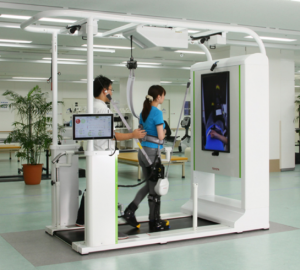หุ่นยนต์ช่วยเดิน…มีดีอย่างไร
ในปัจจุบันมีการนำเทคโนโลยีต่างๆ มากมาย เข้ามาเพื่อช่วยการฟื้นฟูการเคลื่อนไหวที่ผิดปกติ ที่มาจากระบบประสาท ระบบหลอดเลือดสมอง หรือระบบไขสันหลัง หนึ่งในเทคโนโลยีที่ผู้ป่วยหลายคนรู้จัก และไม่พูดถึงไม่ได้นั้นก็คือ “หุ่นยนต์ช่วยเดิน” (Robot Assisted Gait Training หรือ RAGT) หุ่นยนต์ช่วยเดินสามารถช่วยปรับท่าทางการเดินในผู้ป่วย และสามารถรับน้ำหนักตัวผู้ป่วยพร้อมพาผู้ป่วยเดินแทนนักกายภาพบำบัดได้ หุ่นยนต์ฝึกเดินแบ่งออกได้ 4 ประเภทหลักๆ คือ
- Treadmill-based robotic: การเดินบนลู่วิ่ง และมีระบบช่วยพยุงลำตัว สำหรับหุ่นยนต์ฝึกเดินประเภทนี้เหมาะสำหรับผู้ป่วยที่ต้องการปรับการวางเท้า การก้าวขาเดินอย่างถูกต้องสวยงาม และมีระบบช่วยพยุงตัวจึงไม่ต้องห่วงเรื่องการลงน้ำหนักเลย
- Mobile robotic: ช่วยพยุงขาทั้ง 2 ข้างให้สามารถเดินไปในทิศทางต่างๆ ได้ โดยผู้ป่วยที่จะใช้อุปกรณ์นี้ได้จะต้องมีแรงของลำตัวที่แข็งแรง และสามารถก้าวขาเดินเองได้บ้างแล้ว
- Stationary robotic base: ส่งเสริมการเคลื่อนไหวขา ช่วยเคลื่อนไหวข้อต่อของขาทั้ง 2 ข้าง หุ่นยนต์ฝึกเดินประเภทนี้เหมาะสำหรับผู้ป่วยที่ต้องการเพิ่มกำลัง และความทนทานของกล้ามเนื้อขา
- Ankle and knee rehabilitation system: เน้นฟื้นฟูการเคลื่อนไหวข้อเท้า หุ่นยนต์ฝึกเดินประเภทนี้เหมาะสำหรับผู้ป่วยที่มีปัญหาการเคลื่อนไหวข้อเท้า เช่น ปลายเท้าตก หรือผู้ที่ต้องการเพิ่มความแข็งแรงของข้อเท้า
รูปที่ 1 Robot Assisted Gait Training
หุ่นยนต์ช่วยเดินมีหลายประเภท แต่ละประเภทก็เหมาะกับความสามารถ และปัญหาที่แตกต่างกัน ทั้งนี้ สามารถปรึกษาคุณหมอ หรือนักกายภาพบำบัดที่ดูแลคนไข้ ก่อนตัดสินใจได้ ที่สำคัญเลยการฟื้นฟูโดยใช้หุ่นยนต์ช่วยเดิน เป็นหนึ่งในอุปกรณ์ช่วยฟื้นฟูเท่านั้น และหากจะเกิดประโยชน์สูดสุดคนไข้จำเป็นต้องตั้งใจฝึกออกแรงร่วมกับหุ่นยนต์ และคิดตามการออกแรงทุกครั้งเพื่อสอนให้สมองเกิดการเรียนรู้ สิ่งที่ไม่ควรทำเลย คือการปล่อยให้หุ่นยนต์เดินไปเรื่อยๆ โดยไม่ได้คิดหรือออกแรงตามเลย
Robots to help walk…how good is it?
Many technologies are being used today to help restore abnormal movements. originating from the nervous system cerebral vascular system or spinal cord One of the technologies that many patients know. and not to mention that it is “Robot Assisted Gait Training (RAGT) Robotic walking aids can help adjust walking posture in patients. and able to support the patient’s body weight and walk the patient instead of the
physical therapist Walking training robots can be divided into four main categories:
1. Treadmill-based robotic: Walking on a treadmill. and has a body support system This type of walking robot is suitable for patients who need to adjust their foot placement. Walking properly and beautifully. and has a support system so you don’t have to worry about losing weight
2. Mobile robotic: It helps support both legs so that they can walk in different directions. The patient who can use this device must have strong body strength. and able to walk on its own
3. Stationary robotic base: promote leg movement Helps move the joints of both legs. This type of walking robot is suitable for patients who need to increase their strength. and endurance of leg muscles
4. Ankle and knee rehabilitation system: focuses on restoring ankle movement. This type of walking robot is ideal for patients with ankle mobility problems such as dropping their toes.
เอกสารอ้างอิง
1.ชนาทิพย์ พลพิจิตร์. (2561). การฟื้นฟูการเดินโดยใช้หุ่นยนต์ฝึกเดิน Gait recovery with robotic gait training. [อินเตอร์เน็ต]. [เข้าถึงเมื่อ 4 มิถุนายน 2565].
- REBRAIN ทีมนักกายภาพบำบัดเฉพาะทาง. (2564). หุ่นยนต์ฝึกเดิน กับการทำกายภาพบำบัด. [อินเตอร์เน็ต]. [เข้าถึงเมื่อ 19 มิถุนายน 2565].
